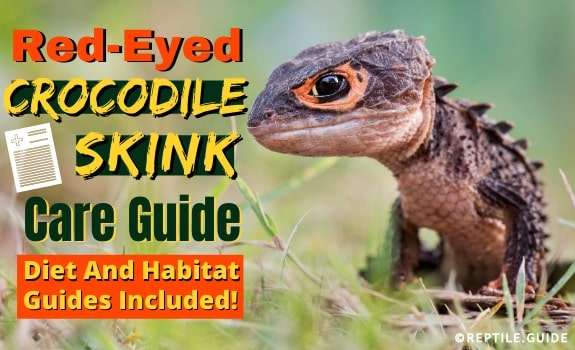As a reptile enthusiast, you’re sure to love the exotic red-eyed crocodile skink.
These unique lizards have gorgeous features that will delight you and create an intriguing conversation topic among visitors.
No matter whether you’re a newbie to reptile care, or a more seasoned herp pro, the red-eyed crocodile skink is a perfect lizard pet (opens in a new tab) for beginners and experts alike.
If you’re unsure how to begin your foray into reptile-keeping, or looking for more tips on the best method of ensuring your crocodile skink is happy and healthy, you’ve come to the right place.
Our red-eyed crocodile skink care guide is packed full of interesting tidbits and useful information GUARANTEED to make you an expert skink owner, regardless of your current skill level.
What You’ll Discover About Red-Eyed Crocodile Skinks Inside This Guide:
- Lifespan, size, and other interesting ownership factoids
- The best place to buy a crocodile skink (plus what to avoid!)
- Proper diet for all ages
- Expert habitat and enclosure setup
- Health concerns to be aware of (plus how to prevent them!)
- Handling & bonding tips
- & So much more!
Let’s dive into learning more about these unusual little lizards and the best husbandry practices to help this species thrive!
In This Article
Red-Eyed Crocodile Skink Species Overview
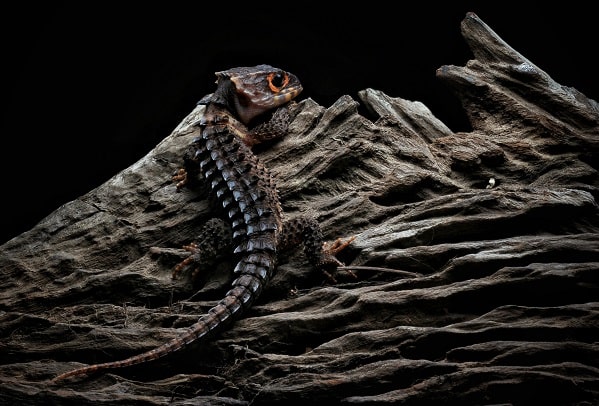
As people are on the lookout for more unique pets, red-eyed crocodile skinks are rapidly growing in popularity. Not only do they look like baby dragons, but they also require minimal upkeep to remain healthy.
Red-eyed crocodile skinks have strong, stout bodies and legs and are generally a dark brown with a cream-colored underbelly.
The other unique characteristic of this lizard is the decorative bright reddish-orange scales circling the eyes.
The length of an adult crocodile skink is approximately 7 to 9 inches in length from snout to tail.
In captivity, red-eyed crocodile skinks can live as long as 10 to 14 years. With proper care and love, your crocodile skink may be around to provide companionship for over a decade!
| Facts at a Glance: | |
|---|---|
| Common Name | Red-Eyed Crocodile Skink |
| Scientific Name | Tribolontus gracilis |
| Average Adult Size | 7-9 inches |
| Price | $150-$250 |
| Setup Cost | $200-$250 |
| Lifespan | 10-14 years |
| Diet | Insects |
| Tank Size | 20 gallons |
| Temperature | 73-84 degrees F |
| Humidity | 70-90% |
| Popular Alternatives | Blue Tongued Skinks, Mexican Alligator Lizard |
Buying a Red-Eyed Crocodile Skink
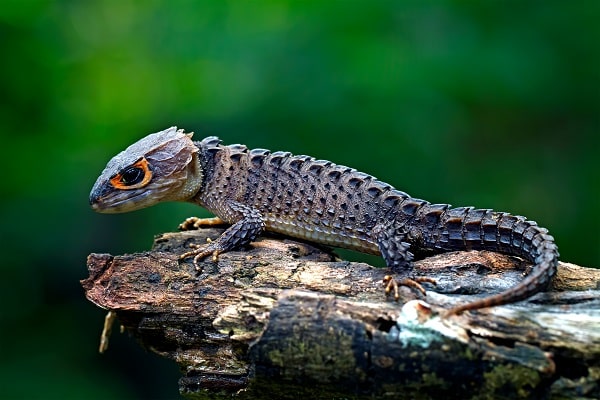
Red-eyed crocodile skinks are difficult to find in pet stores, unless they are small, locally-owned stores that specialize in exotic reptiles.
Due to their popularity among breeders, and lack of availability in pet stores, a breeder is your BEST resource for purchasing one of these unique lizards.
Perform a simple search online for crocodile skink breeders and look for ones with excellent reviews and live-delivery guarantees.
Before jumping into purchasing a red-eyed crocodile skink, budget appropriately for this adorable tiny dragon.
On average, a crocodile skink will cost anywhere from $150 to $250, plus up to $50 in shipping.
Also, although you may be tempted to make your first order of business selecting a cool name, be sure you have the proper red-eyed crocodile skink habitat before purchasing one (more on this later).
Once your new crocodile skink arrives…
- Check to ensure they are healthy (see below)
- Quarantine your new pet in a small, sparsely decorated container for easy observation.
| Healthy Signs | Unhealthy Signs |
|---|---|
| Bright, alert eyes | Sores or marks on the skin |
| Healthy appetite | Limbing |
| Moist gums | Sunken eyes |
| Supple skin | Bowed legs |
| Frisky and alert | Unusual flexibility of the lower jaw |
🤓 Expert Tip: Keep a close eye on your new pet’s stool, and take a fresh fecal sample to your veterinarian to check for intestinal parasites. Once your skink has received a clean bill of health, you can move it to a more permanent habitat, alone or with a potential breeding partner.
Red-Eyed Crocodile Skink Diet and Feeding Guidelines
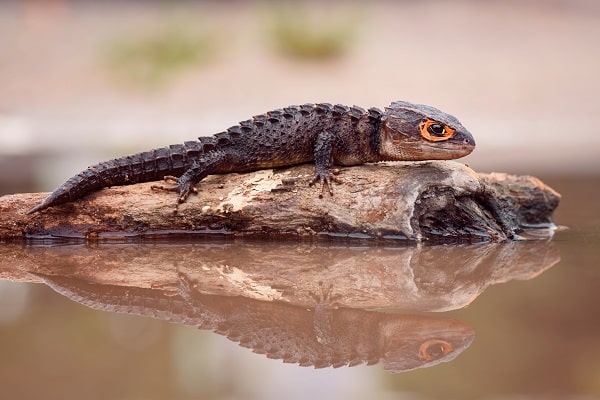
Red-eyed crocodile skinks should be fed a variety of small insects, which should be dusted with a mixture of a reptile vitamin and calcium supplement.
Examples of insects to feed your Red-Eyed Crocodile Skink include:
- Grubs
- Crickets
- Dubia roaches
- Waxworms
- Mealworms
- Superworms
- Earthworms
By feeding a variety of insects that have been gut-loaded and dusted with vitamins, you can ensure your baby skink will grow up to be strong and healthy!
Lastly, do NOT overfeed vitamin D3. Using calcium with vitamin D3 is recommended, but no more than twice a week.
Since red-eyed crocodile skinks are such tiny reptiles, they don’t require much food to maintain a healthy weight.
Feeding this pet is relatively inexpensive.
In fact, you may only spend a few dollars a month on both insect and supplement costs based on your skink’s age.
How Often to Feed Your Red-Eyed Crocodile Skink
How often you feed your pet will depend on your skink’s age. You will feed them either every 24 or 48 hours as noted in the feeding chart below.
| Crocodile Skink Feeding Schedule | |
|---|---|
| Babies and Juveniles | 2 crickets (or the equivalent of a different insect) every 24 hours |
| Adults | 3 crickets (or the equivalent of a different insect) every 48 hours |
But regardless of their age, it’s best if you stick to the dusk and dawn feeding routine they are used to in the wild.
Red-Eyed Crocodile Skink Habitat and Tank Setup
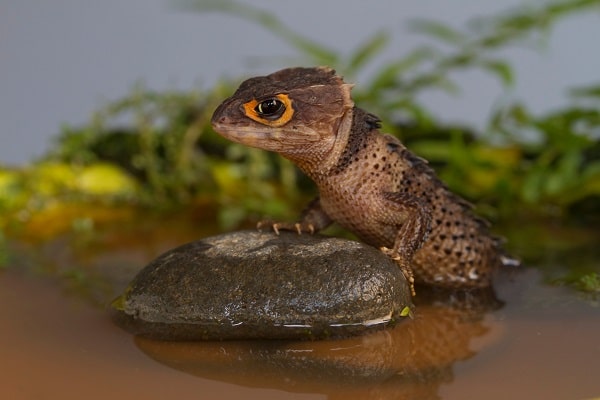
Providing your crocodile skink with the proper habitat is crucial to both their overall health and happiness.
Some example items to include inside your crocodile skink’s habitat include:
- Water dish
- Feeding dish
- Coconut hides
- Cork bark hides
- Mister or fogger
- Under-the-tank heater
- Lighting
- Temperature and humidity gauges
- Live plants
- Large fake plants
- Substrate
Enclosure Size
Juvenile and adult red-eyed crocodile skinks do not require a difference in enclosure size, but if you are housing a breeding pair, you need to provide more space.
A tank size of at least 20 gallons should be sufficient for housing one crocodile skink, whereas an enclosure size of 55-gallons is ideal for housing a pair.
An adult pair may be comfortably maintained in a 3-foot-square aquarium containing 3 to 6 inches of substrate.
Type of Enclosures
Red-eyed crocodile skinks thrive in various forms of glass enclosures.
Whether you opt for a terrarium, old fish tank, or aquarium, all these options work well at holding humidity and staying warm enough for your skink.
Be sure to purchase a wire or mesh top for your enclosure to prevent escaping, because they can climb well if given the opportunity!
Lighting and Temperature Requirements
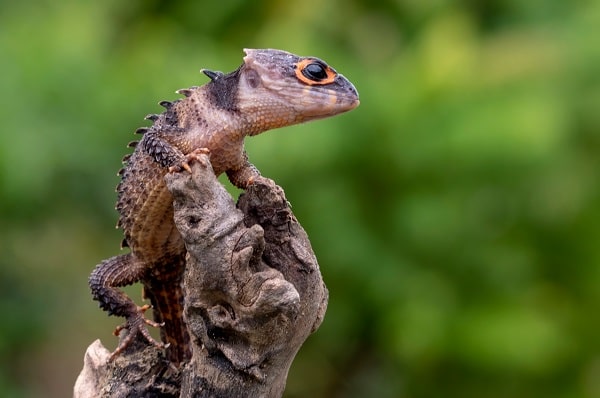
Red-eyed crocodile skinks prefer daytime temperatures in the area of 82 to 84 degrees Fahrenheit, but should ideally reach at least 75 degrees.
In contrast, nighttime temperatures can be as low as 73 degrees, but should not dip below 70.
As with most other reptiles, provide both a warm and cool side in the enclosure to offer a temperature gradient to keep your skink happy and comfortable, even though crocodile skinks do not appear to bask much in the wild.
Although you are supplementing your skink’s diet with vitamin D3, you should provide UVB lighting if there is not much natural light exposure near your pet’s enclosure.
UVB spectrum light with a 12-hour light cycle should be used to ensure your crocodile skink remains healthy and gets its dose of daily sunlight.
Humidity Levels
As a tropical lizard, red-eyed crocodile skinks prefer high humidity levels at all times, up to 90%.
A minimum of 70% humidity is required for a healthy skink to allow for proper growth and shedding and preventing dehydration.
Having the correct substrate at an appropriate depth goes a long way toward maintaining the correct humidity level, but you can also mist the substrate as needed to prevent it from drying out from the light and heating lamps.
Substrate
Red-eyed crocodile skinks need a substrate that promotes evaporation for high humidity levels while not encouraging mold at the same time.
For these reasons, Reptile.Guide recommends using layered substrates for this species.
Layered substrates work best to:
- Hold humidity
- Control smell
- Prevent mold
- Provide ample opportunity for your reptile to burrow
- Encourage colonies of edible microfauna to grow
An ideal layered substrate has a 1 to 2 inch upper layer of long-fiber sphagnum moss, topped with brown oak leaves and wicking or drainage lower layer of hydroponic clay.
By maintaining a shallow water level in the bottom hydroponic layer, water will continuously wick up to the top layer, providing a constant, regulated humidity supply.
⭐️ Fun Fact: Did you know? In addition to controlling smell and preventing mold, layered substrates also encourage colonies of edible micro-fauna to grow, providing a natural habitat for your skink to forage through and burrow into.
However, you can also use a humidity-friendly substrate like forest-floor cypress mulch, peat moss, or coconut fiber, providing you keep a close eye on humidity levels and mist the substrate as needed.
Decor and Accessories
Although capable climbers, red-eyed crocodile skinks in the wild spend most of their time on the ground, searching for grubs, small worms, and insects.
While they don’t necessarily require plants and branches for climbing decor, natural or artificial fauna adds a beautiful element to your lizard’s enclosure.
Rather than climbing, crocodile skinks prefer swimming and will dehydrate rapidly if kept too dry.
In addition to plants, provide several hides.
Large coconut huts or curved pieces of cork bark create excellent hiding options for your crocodile skink.
Be sure to place one at each end of the enclosure’s temperature gradient to offer a cool and warm hiding area.
Red-Eyed Crocodile Skink Health Information
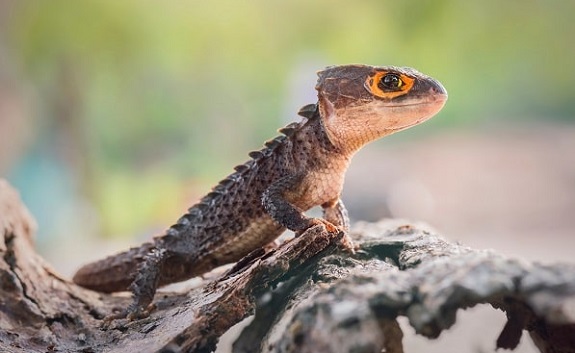
Little is known about the red-eyed crocodile skink’s prevalence for certain diseases, outside of intestinal parasites and metabolic bone disease, which is typical for reptiles.
Most animals who were once healthy when caught from the wild seem to die with no cause, but the most common issue captive skinks suffer from is metabolic bone disease.
Metabolic Bone Disease (MBD)
Like all captive reptiles, there is a concern for metabolic bone disease development in red-eyed crocodile skinks.
MBD can manifest into any of the following examples:
- Limping
- Bowed legs
- A wobbly gait
- Unusual flexibility of the lower jaw
Caused by a lack of calcium or vitamin D3 in the diet, this disease is always a concern for captive reptiles because reptiles cannot utilize vitamin D3 without UV light, and calcium cannot be properly metabolized without adequate vitamin D3 present.
Fortunately, metabolic bone disease can easily be prevented by dusting insects with a mixture of calcium powder and vitamin D3 supplements.
Red-Eyed Crocodile Skink Handling and Bonding Tips
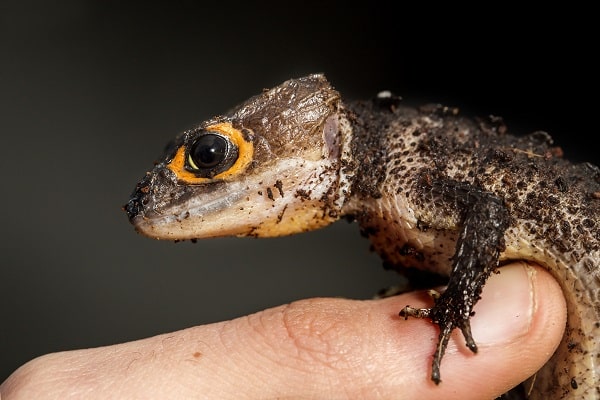
Handling should be infrequent to minimize stress and maintain good health.
However, you can check your crocodile skink’s health occasionally by placing them on your flat hand for observation.
Although they rarely bite, crocodile skinks are uncomfortable being handled, and are best regarded as display animals.
When picked up or held, crocodile skinks will often emit a high-pitched yelping sound in distress.
Sometimes these panic-stricken sounds may be followed by a bout of vomiting and tail shedding.
However, if this display doesn’t scare off potential threats, they’ll freeze or play dead.
⭐️ Fun Fact: Despite their reluctance to be handled on a regular basis, they do make stunning additions to display terrariums, where they are compatible with dart frogs, day geckos, crested geckos, and other small frogs and lizards with habitat requirements similar to theirs.
Red-Eyed Crocodile Skink Care Guide Summary
If you’re looking to add an exotic-appearing lizard to your home that requires minimal upkeep, a red-eyed crocodile skink is a perfect pet for you!
While gorgeous to look at, with their bold red scales surrounding their dark eyes, red-eyed crocodile skinks do not make the best pets for children, due to their less-than-sociable nature.
However, they are easy to care for, especially when compared to some other exotic reptile species, and require little interaction and minimal food to be happy and healthy.
Another unique characteristic of these reptiles is that you can house them in groups. However, veterinarians recommend NEVER housing males together.
You can also house them with other frogs and lizards with similar humidity and temperature requirements, making them especially unusual, but an interesting pet.
Still on the fence about owning one as a pet? Consider the following pros and cons…
| Pros | Cons |
| Easy to care for | Uncomfortable being handled |
| Unique, exotic appearance | Can be costly |
| An average decade long lifespan | Not much is known about them |
| Simple diet and feeding routines |
It is our hope that this care guide has helped you decide whether or not a red-eyed crocodile skink is right for you and your family.
Keep this guide handy when setting up your skink’s habitat and choosing its diet, and you can rest assured you’ve created the optimal habitat for your incredible new lizard.
If you just can’t get enough of skinks, check out the monkey-tailed skink. Not only is it the largest skink species, but it also a prehensile tail!
Or check out the blue-tailed skink, which—as you may have guessed—has an eye-catching blue tail.
And the pink-tongued skink is beginner-friendly option for newer reptile keepers.
